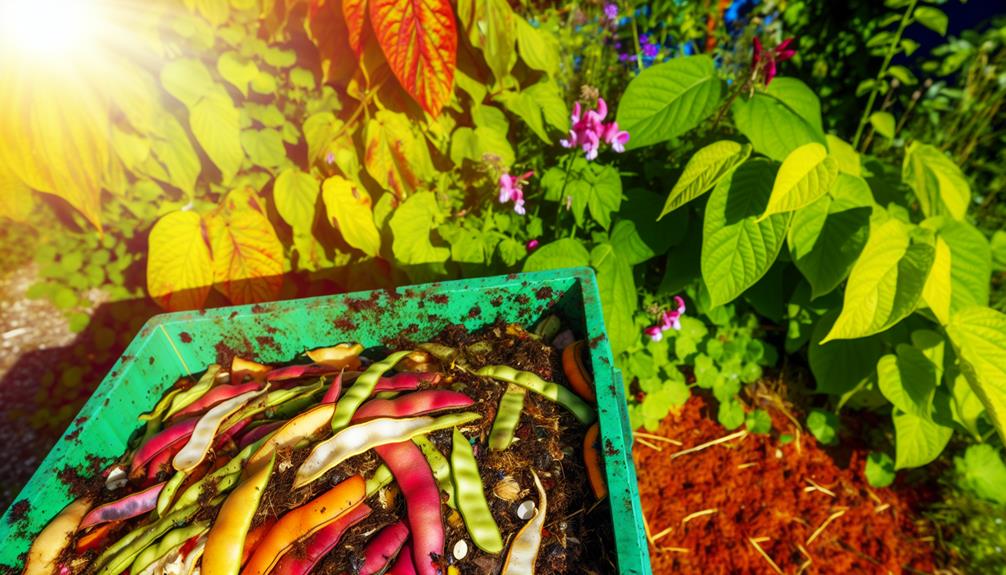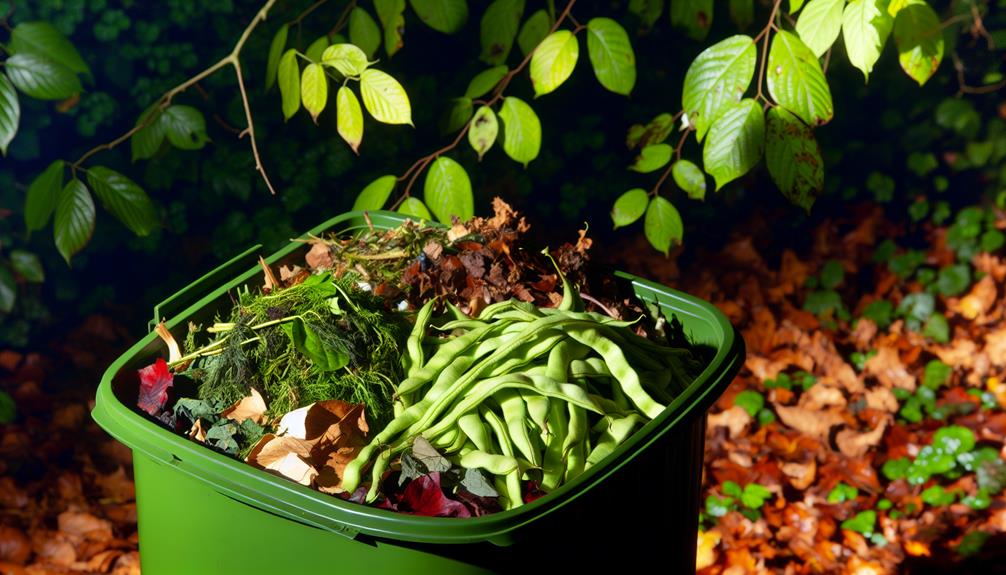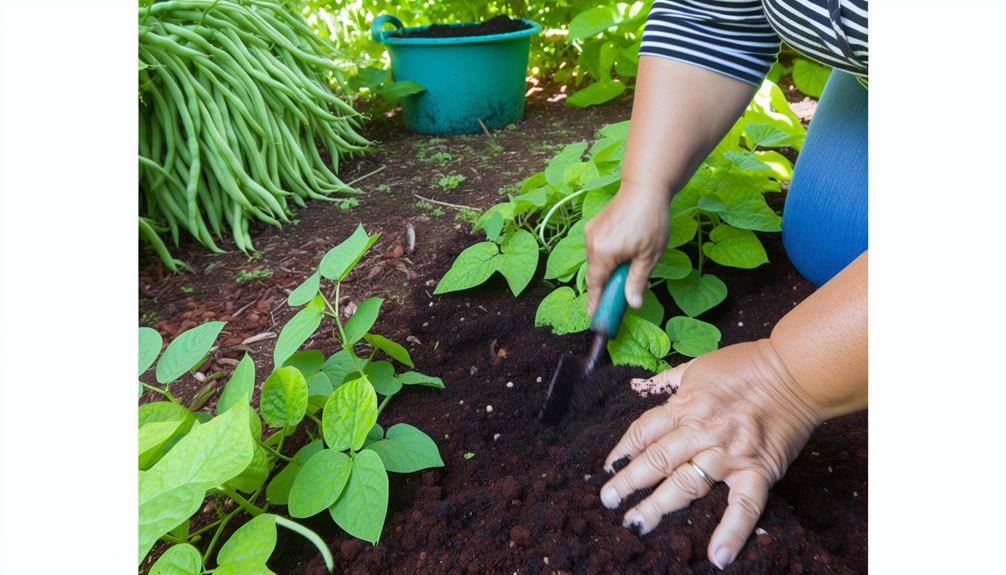

Yes, you can compost runner beans. Start by chopping the stems into smaller pieces to speed up decomposition. Remove seeds from the pods to avoid accidental planting. Mix the chopped beans with other compost materials, maintaining a 3:1 ratio of brown to green materials for balanced composting. Layering brown materials like leaves at the bottom helps with aeration.
Avoid common mistakes such as including plastic contaminants, and make sure your compost is properly aerated and moist. Using the resulting compost will enrich your garden soil, promote healthy plant growth, and improve soil structure. For more tips, continue exploring composting techniques.
Composting runner beans not only reduces waste but also enriches your soil with essential nutrients. You’ll find that including these beans in your compost pile promotes soil enrichment by adding important components back into the earth. This process of nutrient recycling guarantees that your garden remains fertile and productive year after year. When you compost runner beans, you’re participating in a natural cycle that benefits both your plants and the environment.
By adding runner beans to your compost, you can improve the structure and quality of the soil. The organic matter breaks down, creating a rich, dark humus that enhances soil fertility. This humus retains moisture and provides a habitat for beneficial microorganisms. These microorganisms play an important role in nutrient recycling by breaking down organic material into forms that plants can readily absorb.
Moreover, composting runner beans helps reduce the amount of organic waste that ends up in landfills, contributing to a more sustainable lifestyle. It’s a simple yet effective way to make your garden more eco-friendly.
Embrace composting as a communal activity that not only supports your garden but also fosters a sense of belonging within the gardening community.
Also Read: Can You Compost Ice Cream?
To get the most out of composting runner beans, you need to prepare them properly before adding them to your compost pile. Start by cutting stems into smaller pieces. This step is crucial because smaller pieces break down more quickly, speeding up the composting process. Use a sharp knife or garden shears to make the job easier and more efficient.
Next, focus on removing seeds from the pods. Seeds can take longer to decompose, and they might even sprout in your compost pile, creating unwanted plants. Simply open the pods and take out the seeds before adding the pods to your compost. You can either discard the seeds or use them for another purpose, like planting or cooking.
Once you’ve cut the stems and removed the seeds, mix the prepared runner beans with other compost materials. This helps to create a balanced compost pile and ensures even decomposition.
Achieving a balanced compost pile means maintaining the right ratio of green and brown materials. This compost balance is essential for efficient decomposition. Green materials, like runner beans, are rich in nitrogen. They provide the necessary nutrients for microorganisms to thrive.

In contrast, brown materials, such as dried leaves or cardboard, are high in carbon. They help create air pockets and absorb excess moisture.
To strike the right compost ratios, aim for roughly three parts brown materials to one part green materials. This 3:1 ratio guarantees your compost pile has enough aeration and moisture balance.
Start by layering brown materials at the bottom, followed by a layer of green materials. Continue alternating layers until your pile is built.
Turn your compost pile regularly to maintain proper aeration. This helps the materials break down more efficiently. If your pile is too wet and smells, add more brown materials. If it’s too dry, add more green materials and a bit of water.
Also Read: Can You Compost Mail?
Despite your best efforts, several common composting mistakes can hinder the decomposition process and reduce the quality of your compost. One frequent issue is plastic contamination. Even small pieces of plastic can persist in your compost, making it less effective and potentially harmful to the environment. Always double-check for plastic labels or packaging mixed in with your compostable materials.
Another frequent mistake is improper layering. A well-balanced compost pile relies on alternating layers of green (nitrogen-rich) and brown (carbon-rich) materials. If you throw in all your kitchen scraps at once without adding enough brown materials like dried leaves or cardboard, the pile can become too wet and start to smell.
Conversely, too much brown material can slow down the decomposition process, leaving you with a pile that takes forever to break down.
Also Read: Can You Compost Rust?
Now that you’re aware of common composting mistakes, let’s explore how to effectively use your compost in your garden. Compost is an excellent resource for soil enrichment, improving the overall health and fertility of your garden beds.

Start by spreading a layer of compost about two to three inches thick over your garden soil. This layer will help guarantee moisture retention, suppress weeds, and provide essential nutrients to your plants.
Another great way to utilize your compost is by making compost tea. Compost tea is a nutrient-rich liquid that’s easy to prepare. Simply steep a bag of compost in water for 24 to 48 hours, then strain and apply it to your plants. This tea provides a quick nutrient boost and promotes healthier growth.
Incorporate compost into your planting holes when setting out new plants or seeds. Mix it thoroughly with the existing soil to secure even distribution of nutrients. Additionally, side-dressing with compost during the growing season can give established plants an extra push.
Using these methods, you’ll create a thriving garden, fostering a sense of community and belonging with fellow gardeners who share your passion for sustainable practices.
You shouldn’t compost runner bean plants with diseases. It’s essential for disease management. Without proper compost sterilization, pathogens might survive and spread. Join the community in keeping our gardens healthy and thriving by disposing of diseased plants properly.
You’ve asked about the decomposition time of runner beans. They typically break down within 3-6 months. Since they’re organic matter, they enrich your compost pile, helping you create a thriving, sustainable garden community.
Yes, you can compost runner bean seeds. They’ll decompose and enhance the nutrient content of your compost. Just make sure they don’t germinate by chopping them up. Your garden will thrive with this added richness.
You can definitely compost runner beans in a small apartment. Indoor composting or using a balcony compost setup makes it easy. Join the eco-friendly community and start turning your kitchen scraps into rich compost today!
Yes, runner beans can attract pests, but with proper pest management and compost aeration, you’ll minimize issues. By turning the pile regularly, you’ll promote a healthy compost environment and feel like part of an eco-friendly community.
To wrap up, composting runner beans is a great way to enrich your garden. Start by chopping the beans into smaller pieces, balancing them with browns like dried leaves.
Avoid common mistakes like adding too many greens or neglecting to turn the pile. Use the resulting compost to boost soil health and plant growth.
By following these tips, you’ll effectively recycle kitchen waste and support a thriving garden ecosystem.
